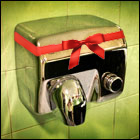|
DocCynical posted:Proper tool for that job is the thumb detecting nut fucker. Being as I mostly do stage stuff nowadays, almost all my wrenching needs are taken care of by a quad reversible ratchet spanner, and a wingnut spanner with 17mm, 19mm and 21mm. I loaned the wingnut spanner to one of my crew to rig some lanterns to the wind-up stands at an event in August. What we found when we took them down, was a divot, about 2mm deep into the scaff bar, complete with thread in the sides. Plastic deformation all the way. It was a beautiful thing, and I could have sworn I took a photograph of it so that I could share it with you. No-one owned up to it, though I feel like I ought to have apologised to the hire company. Though we're the crew that pioneered the use of an 18" long 1" diameter drift to remove truss pins without having to mess around with the truss hammer in the middle of the truss. We had a 3rd-party rigger working with us last year, he looked like he'd seen a god.
|
|
|
|

|
| # ? May 11, 2024 13:40 |
|
I'm fascinated, but can someone please translate the above to English?
|
|
|
|
It's like when I discovered Douglas Adams as a kid and spent the whole third book wondering wtf a "bail" was
|
|
|
|
|
bolind posted:I'm fascinated, but can someone please translate the above to English? Which bit? I also do stage stuff. Wingnut spanner: http://wingnutspanner.co.uk/ There are many different varieties. They all allow one to tighten a wingnut down tighter than you can with your fingers (thus eliminating the point of a wingnut). Why?  Here is a stage light, hung on a piece of aluminium truss. This is formed from several parallel 2" scaffold tubes with cross bracing to provide strength (the more serious stage trusses are pretty loving mental and can hold several tons of equipment across their span). The clamp in this image is known as a "G clamp" due to it's shape. The wignut (shown here in the foreground) presses against the aluminium tube to stop the light from swinging once hung. This type of clamp is only designed to be used with the load hanging vertically (as in the picture). If you want to have this light sticking out the side of the truss, you can do it, but you will struggle to get enough pressure on the wingnut to hold it in place. Enter the wingnut spanner - a great tool which will allow you to tighten the everliving gently caress out of that wingnut, thus holding the lantern in place. This is A Bad Idea as it exposes the soft aluminium pipe to damage (for example, creating a divot, 2mm deep in the pipe), and generally operates outside of the specifications of the clamp. Clamps such as this can deform under these loads (and the cast iron equivalent clamps often used in the US are known to shatter when exposed to these forces. This is a bad thing as it can result in the light falling to the ground. There are many different types of clamps available, and a good number of these provide clamping force across the whole circumference of the pipe. See below:  However these clamps are more expensive and require a second hand to latch, difficult when hanging larger, heavier fixtures. As for truss pins:   Most stage trussing has flanged ends which can be used to mate multiple sections together to create longer trusses. Most truss seconds come in lengths of up to 3m (10'), but it's not unheard to to create trusses which are several hundred feet long. Pins are inserted into the mated flanges to hold the truss sections together, and a R shaped clip is inserted to hold the pin in place. A soft hammer (usually with plastic faces) is used to remove these aluminium pins when it is time to split the truss apart for transport. these days, many popular brands of truss use tapered pins, allowing for easier insertion and removal. A drift is useful to remove pins, as getting a hammer inside the box section of the truss and attempting to swing it is often met with disappointment. Pins are often inserted from the outside, and removed by hitting them outwards from the centre of the truss. Though, with tapered pins, less force is required, and the "hit it where it goes through!" method often works as well.   Here is an image of some tapered pins, along with the conical spigots used to join trusses (having all truss ends be 'female' is useful for obvious reasons). This method of joining sections is used by many manufacturers. An example piece of trussing which would receive these spigots is pictured also. The holes in the spigots are tapered, just like the pins. The holes near the ends of the truss (where you push the pins in) are sized to accept pins being pushed from the outside inwards. If you put the spigots in backwards and attempt to hammer the pins into them, then You're Gonna Have A Bad Time. Riggers are guys who are responsible for the hanging of said trusses, and are (legally) responsible if they fall down. Edit: anyone interested in the hanging of stuff in the roofs of arenas might liek to read this handy booklet: https://www.prolyte.com/uploads/bestanden/Brochures/Blackbook%202016%20web.pdf Pomp and Circumcized fucked around with this message at 15:53 on Sep 29, 2016 |
|
|
|
nene posted:For some inexplicable reason, that podger appears to have a hammer head cast into it. https://www.youtube.com/watch?v=xXyhJB3zYNU
|
|
|
|
Pomp and Circumcized posted:This type of clamp is only designed to be used with the load hanging vertically (as in the picture). If you want to have this light sticking out the side of the truss, you can do it, but you will struggle to get enough pressure on the wingnut to hold it in place. Enter the wingnut spanner - a great tool which will allow you to tighten the everliving gently caress out of that wingnut, thus holding the lantern in place. This is A Bad Idea as it exposes the soft aluminium pipe to damage (for example, creating a divot, 2mm deep in the pipe), and generally operates outside of the specifications of the clamp. This is the reason why I asked if anyone wanted to own up to it. There was no need to wind that fucker down until it glowed, the lamps were all hanging vertically. There are two main reasons to use a wingnut spanner. The first is that once you've attached it to a wingnut you have enough mechanical leverage to spin the wingnut with a single finger, and this can save significant time putting up the fixtures. The second is that once you've done up the g-clamp, they also contain nut spanners that let you tighten the g-clamp to yoke connection to hold it in place, so putting up a fixture takes less than 30 seconds and uses a tool in each hand. This might not sound like much, but when you're hanging lamps for a large show, it makes a huge difference. Pomp and Circumcized posted:Clamps such as this can deform under these loads (and the cast iron equivalent clamps often used in the US are known to shatter when exposed to these forces. This is a bad thing as it can result in the light falling to the ground. This is why we have safety chains and safety bonds. The main problem is that people tightening the everloving gently caress out of these, do it to thick-wall aluminium truss as well. That means you don't get plastic deformation, you end up with sharp slivers and burrs of aluminium sticking out of the truss. Do it enough and the length of truss is junk, but even after a few of these chucklefucks have been at a length of truss, you have something with nearly invisible razors sticking out of it waiting to slice the unwary. Almost everyone wears gloves, but that doesn't help exposed skin on arms and legs. Do not bleed on the stage, it is slippery. Pomp and Circumcized posted:
You mostly find these on larger fixtures, moving heads, or weirdly shaped ones like sunstrips. This one seems to have no safety chain though. The advantage is you can mount them at any angle you want and they'll stay put. The disadvantage is that mounting a fixture is now a two or three person job. On the other hand, that's not a bad thing when the fixture you're mounting weighs anywhere between 30 and 60 kg Pomp and Circumcized posted:
Most people I know in this line of things has put an egg in the wrong way around at least once. Fortunately you can use a spare pin to hammer the jammed pin back out, or use the pointy end of a podger. A podger is that spanner with a pointy bit on one end, so that you can slide it into a hole between two sections to align them. They're very handy when working with hired truss, which has typically had a hard life. Often two pieces of truss won't quite fit together enough to get a pin into it, which is annoying since with the taper on the pins and the spigots (eggs) everything usually self-aligns. At this point your trusty podger is more pointy than a pin, so you can wiggle and hammer it in place of a pin to align things. A metal podger with a metal hammer face is not a happy thing, because metal-on-metal impacts are loud, and will deform the softer metal. Pomp and Circumcized posted:Riggers are guys who are responsible for the hanging of said trusses, and are (legally) responsible if they fall down. On the other hand, it produces truly magnificent mechanical failures, I'll post a few of them in a little bit. Pomp and Circumcized posted:Edit: anyone interested in the hanging of stuff in the roofs of arenas might liek to read this handy booklet: https://www.prolyte.com/uploads/bestanden/Brochures/Blackbook%202016%20web.pdf
|
|
|
|
Pomp and Circumcized posted:Wingnut spanner: http://wingnutspanner.co.uk/ https://www.youtube.com/watch?v=nbkfNCZtCJ8&t=228s
|
|
|
|
After the stage and rigging talk, here's what happens when it goes wrong. There's no pictures with actual dead people in them, but when this goes wrong it goes really really wrong.    This was the result of a supergrid failure, during the load in for a Justin Timberlake and Christina Aguilera concert a little over 10 years ago. The supergrid's roof attachment points failed, and the show's rigging, truss, lighting and sound rode the supergrid down. I don't know whether it was because the supergrid was overloaded by the show, or because the roof points weren't up to spec. In the UK all rigging points are tested yearly under LOLER regulations to try to avoid this. Every truss I design, I calculate the loads at every support point to make sure they're in spec, and reference the loads against the table for each span of truss in the Black Book.  Another rigging points failure.   I think this was basically just criminal negligence. See those supports? They're Genie Superlifts. They're meant for temporarily supporting or lifting things being hoisted into position, not supporting a roof and truss. They aren't even really designed to be used at all outdoors, though they do have outriggers for supporting loads. Here they were placed on soft ground, with wind loads, and no outriggers. They fell over. There were no anchors, no guy lines, and the truss was attached to the superlifts using loving ratchet straps. The wind picked up a little, the roof acted like a giant sail, and over it went. I use Superlifts a reasonable amount, they're really useful for lifting a truss structure up onto legs, or a particularly large item like a followspot chair. They don't have any safety catches though, so your whole load is supported by the cable drum and the cable.    This was during load in and setup for a Radiohead show. I don't have any details of what happened here, and I couldn't find much. I presume this is because it's still the subject of legal action in Canada.   This was at an Indiana State Fair, and again the roof acted like a sail and the whole thing toppled over. In this case they are at least using proper truss towers, but it looks like it wasn't guyed and anchored. In the second picture, there are people still alive, trapped under the fallen roof beam, and there are first responders and audience members lifting it up to extract them. They were saved by the beam landing on fixtures hung below the beam, which supported it and protected them. Six people weren't so lucky, and I'm not going to post any other pictures of the aftermath. This was a dark day for the entertainment industry.  Another weather related failure. There's nothing else from this event I feel comfortable posting, and I'm not going to give you any more info to try to find it.  Another failure during load-in, part of the rigging failed and landed that semi-circle in the centre of the stage. Two riggers died during the collapse, but the show carried on after they removed the damaged sections.    Apparently this happened during load in for an event at the Guangxi Sports Centre Arena in 2015. It looks like several sections of truss buckled, causing a cascading failure pulling the support towers over into a giant pretzel of twisted metal. I don't know if this was due to equipment failure or overloading. nene fucked around with this message at 00:38 on Sep 30, 2016 |
|
|
|
FYI google image search basically makes it trivial to find details about these incidents based on the picture. That said, these are basically giant temporary construction projects that have to be done quickly and repeatedly. It's a wonder it doesn't go wrong more often or that more people don't get hurt.
|
|
|
|
Jesus gently caress
|
|
|
|
|
nene posted:After the stage and rigging talk, here's what happens when it goes wrong. There's no pictures with actual dead people in them, but when this goes wrong it goes really really wrong. totalnewbie posted:That said, these are basically giant temporary construction projects that have to be done quickly and repeatedly. It's a wonder it doesn't go wrong more often or that more people don't get hurt. David Lee Roth posted:Van Halen was the first band to take huge productions into tertiary, third-level markets. We'd pull up with nine eighteen-wheeler trucks, full of gear, where the standard was three trucks, max. And there were many, many technical errors — whether it was the girders couldn't support the weight, or the flooring would sink in, or the doors weren't big enough to move the gear through. quote:The folks in Pueblo, Colorado, at the university, took the contract rather kinda casual. They had one of these new rubberized bouncy basketball floorings in their arena. They hadn't read the contract, and weren't sure, really, about the weight of this production; this thing weighed like the business end of a 747.
|
|
|
|
nene posted:This was the result of a supergrid failure, during the load in for a Justin Timberlake and Christina Aguilera concert a little over 10 years ago. The supergrid's roof attachment points failed, and the show's rigging, truss, lighting and sound rode the supergrid down. I don't know whether it was because the supergrid was overloaded by the show, or because the roof points weren't up to spec. In the UK all rigging points are tested yearly under LOLER regulations to try to avoid this. Every truss I design, I calculate the loads at every support point to make sure they're in spec, and reference the loads against the table for each span of truss in the Black Book. IIRC the stage was meant to be at the other end of the venue, and the mothergrid at that end was able to take the load. They switched venue ends at the last minute and nobody recalculated. At least that's the story that went around. Nice post, just two things... nene posted:The first is that once you've attached it to a wingnut you have enough mechanical leverage to spin the wingnut with a single finger, and this can save significant time putting up the fixtures. How have you managed to do this successfully without the spanner falling off or it hitting the truss/fixture? Do you rig on pipes (i.e. with no crossbracing to hit) in theatre? I work with a lot of bellends and I've never seen anyone attempt to Harlem Globetrotter a wingnut. If you really want to spin a wingnut in quickly and gently caress up everyones day, consider a wingnut socket for an impact driver (yeah....those things exist Tightening up a G-clamp with a wingnut spanner is generally frowned upon, as mentioned above. If you know the fixture is going to be rigged at any angle other than hanging vertically, you should fit it with a half-coupler ("cheeseborough" for US goons), a trigger clamp, or any other kind of clamp which encloses the full circumference of the pipe, while applying constant and even pressure across it. Don't be renting nice powder-coated truss and then returning it full of scratches and dents because the guy in prep (even if its you) didn't know to fit the correct kind of clamp. nene posted:The second is that once you've done up the g-clamp, they also contain nut spanners that let you tighten the g-clamp to yoke connection to hold it in place, so putting up a fixture takes less than 30 seconds and uses a tool in each hand. When you're hanging lamps for a large show, you're gonna be speccing Doughty trigger/quick-trigger clamps (or equivalent) which spin down fine and quickly with a single finger. You also have nylok nuts for the yoke attachment properly torqued in prep, so you're not fannying about with tools during the focus. Also most of your rig is pre-rigged into pre-rig truss. You don't want to see any of that bent up steel g-clamp bollocks on a larger show. Also the nut-wrenching ability of most wingnut spanners is pretty poor. A nice combination 17/19mm ratchet ring spanner and an adjustable is going to do a much better job, and they stay in your box until the focus, because who preps lights with loose clamps? I don't want to sound like I'm arguing with you - I'm not and I agree with many of your points. Rather, I'm trying to add onto what you're saying. If you had PMs, I'd hit you up on there. It's a small industry, we've likely worked together at some point.  As for some content, here's a recently 'mechanical' failure. Mechanical in the sense that someone rammed the end of a bit of truss into a lighting fixture. Thanks...  Edit: That superlift stage is pretty Pomp and Circumcized fucked around with this message at 01:29 on Sep 30, 2016 |
|
|
|
totalnewbie posted:FYI google image search basically makes it trivial to find details about these incidents based on the picture. giant temporary construction projects constructed by roadies, half of whom are hungover* Rigging is serious loving business. I am glad I don't have that much responsibility. *the other half are still drunk
|
|
|
|
Eddie Riggs taught me they're all actually heroes.
|
|
|
|
MRC48B posted:giant temporary construction projects constructed by roadies, half of whom are hungover* I learned at age 15 you don't trust rigged trusses. Or that they're not meant to hang off of for stage diving purposes. Either or.
|
|
|
|
Pomp and Circumcized posted:IIRC the stage was meant to be at the other end of the venue, and the mothergrid at that end was able to take the load. They switched venue ends at the last minute and nobody recalculated. At least that's the story that went around. Pomp and Circumcized posted:How have you managed to do this successfully without the spanner falling off or it hitting the truss/fixture? Do you rig on pipes (i.e. with no crossbracing to hit) in theatre? I work with a lot of bellends and I've never seen anyone attempt to Harlem Globetrotter a wingnut. If you're hanging the fixture on truss, if you drop it on with the wingnut facing outwards and the yoke inline with the bar, there's nothing to hit. The spanners I use fit tightly and have wingnut holes at both ends, so I'm not spinning it around with my finger on the outside, it's more like a speed brace. So drop the fixture on the bar, align the yoke, spin the wingnut up to the bar and hand tighten. Next roughly aim the fixture and torque it with the nut driver on the wingnut spanner inside the yoke to hold the bolt stationary, and the 17/19mm ratchet spanner on the g-clamp side. Attach the safety chain/cable, and position the power, and it's done. Pomp and Circumcized posted:If you really want to spin a wingnut in quickly and gently caress up everyones day, consider a wingnut socket for an impact driver (yeah....those things exist Pomp and Circumcized posted:Tightening up a G-clamp with a wingnut spanner is generally frowned upon, as mentioned above. If you know the fixture is going to be rigged at any angle other than hanging vertically, you should fit it with a half-coupler ("cheeseborough" for US goons), a trigger clamp, or any other kind of clamp which encloses the full circumference of the pipe, while applying constant and even pressure across it. Don't be renting nice powder-coated truss and then returning it full of scratches and dents because the guy in prep (even if its you) didn't know to fit the correct kind of clamp. I'd prefer not to use anything but 50mm half couplers on truss anyway, even if it is just hanging vertically. Using g-clamps on truss only makes things worse for ourselves in the long run. That's why I asked for whoever it was that did it to own up, but all I saw was a sea of innocent faces. Pomp and Circumcized posted:When you're hanging lamps for a large show, you're gonna be speccing Doughty trigger/quick-trigger clamps (or equivalent) which spin down fine and quickly with a single finger. You also have nylok nuts for the yoke attachment properly torqued in prep, so you're not fannying about with tools during the focus. Also most of your rig is pre-rigged into pre-rig truss. You don't want to see any of that bent up steel g-clamp bollocks on a larger show. Unfortunately, pre-rigging is something that happens to other people. My only luxury here is specifying the order that the fixtures get loaded onto the meat-racks so we don't have to sort things. It's already a giant and horrible time suck, so I'm thankful for some mercies at least. Every show is different, everything is unique. Most venues we go into don't even have rigging points to fly stuff, so we use things like Doughty Zenith wind up stands, or superlifts to hoist things onto truss legs. Front of house lighting is mostly fixed, and goes on 29mm TV spigot wind up stands. Pomp and Circumcized posted:Also the nut-wrenching ability of most wingnut spanners is pretty poor. A nice combination 17/19mm ratchet ring spanner and an adjustable is going to do a much better job, and they stay in your box until the focus, because who preps lights with loose clamps? I have an adjustable spanner, but it's mostly used in desperation, I don't really like them. Pomp and Circumcized posted:I don't want to sound like I'm arguing with you - I'm not and I agree with many of your points. Rather, I'm trying to add onto what you're saying. If you had PMs, I'd hit you up on there. It's a small industry, we've likely worked together at some point. Pomp and Circumcized posted:As for some content, here's a recently 'mechanical' failure. Mechanical in the sense that someone rammed the end of a bit of truss into a lighting fixture. Thanks... Hopefully it was already programmed, right? Pomp and Circumcized posted:Edit: That superlift stage is pretty I have no idea. Apparently they'd used that "design" many times before, and this was when their luck ran out. Worse still, they were already well into sound check when it went over.
|
|
|
|
I made a 12 & then a 16 channel load cell/force measurement rigs for lifting trusses 20 years ago for the Entertainment Industry. Jands probably still use their one. The opera house still have it there. I put the tension cells above the chain blocks to measure & balance the loads when hoisting. It kept the beams level. With equal force on all the hoisting points. The original idea came from Elton Johns crew that was then copied to the Sydney Opera House & Sydney Entertainment Center (basketball scoreboard) that both deployed load cell rigs the same as Eltons setup. It was a big deal for me back in the day.
|
|
|
|
nene posted:
Same reason Certain People use an impact adapter for oil filters. 
|
|
|
|
MRC48B posted:Same reason Certain People use an impact adapter for oil filters. A wingnut socket is also a great tool when replacing honda civic alternators. Which for some amazing reason have a wingnut to adjust tension.
|
|
|
|
MRC48B posted:Same reason Certain People use an impact adapter for oil filters. Wait.... whut? You are kidding......?
|
|
|
|
nene posted:I doubt it, I've been stuck in a wheelchair for a while now, so I don't do paid stuff any more. No-one's interested in hiring a girl in a wheelchair and one good leg, no matter my experience. On the other hand, volunteer stuff I do is good fun, and we have a good number of people from the industry or who decided they wanted to do it professionally after a few events. We're always happy to have new people join us ... The hours are long, the pay doesn't exist, and the budget hardly ever covers nice things, but I still love it and it scratches the itch. Have you thought about getting into operating? wildemere posted:I made a 12 & then a 16 channel load cell/force measurement rigs for lifting trusses 20 years ago for the Entertainment Industry.... This is awesome. Load cells are popular these days on touring rock'n'roll systems, especially those where trusses move mid show. It's a convenient way to check that every motor on the truss has tension when it's in the air, and it can help satisfy the riggers or structural engineers on site. Some modern chain hosts now have these built in, which is a great thing. MRC48B posted:Same reason Certain People use an impact adapter for oil filters. Hey, it's got to stay on there for 30,000 miles! You don't want to risk it coming off, do you? Removing it will be the next owners problem.
|
|
|
|
I swear, if I ever run a garage or similar, all the rattleguns will be locked to anticlockwise only and the reverser removed. There will be one that runs both ways, and you have to justify why you need it out the cabinet.
|
|
|
|
CAT INTERCEPTOR posted:Wait.... whut? You are kidding......? I've had to chisel several oil filters off the mount, involving the removal of either the exhaust after the headers (done it, 626), an engine mount (done it, older 323) or the intake manifold (seen it done, miata). Also, probably a dozen times I hammered a screwdriver through the filter to use as a handle to turn it. edit: from a couple of hundred pages back in this very thread. Look at the direction that this thing is set up. it's a 3D render, but still Memento fucked around with this message at 11:05 on Sep 30, 2016 |
|
|
|
InitialDave posted:I swear, if I ever run a garage or similar, all the rattleguns will be locked to anticlockwise only and the reverser removed. There will be one that runs both ways, and you have to justify why you need it out the cabinet. My auto shop class was run this way. Any tool you may ever need was locked in a caged off room. The impact gun he kept only came out twice the three years I was in it. Both for honda crank bolts.
|
|
|
|
Memento posted:Also, probably a dozen times I hammered a screwdriver through the filter to use as a handle to turn it. The worst feeling in the world is when you're forced to do this on your only car after having a quick-lube place do the previous change and rather than turning it just mutilates the filter.
|
|
|
|
One of my coworkers at the quicklube was famous for putting filters on stupid tight by hand. He was basically a mountain of a man and I saw him put a filter on so tight with his bare hands that it visibly flexed the sheetmetal can as he turned it once. We didn't let people use sockets to put filters on except those stupid loving plastic sockets that some cartridge filters go into (you know, the ones that always break because brittle plastic is great, thanks Mazda) so worstcase we just called him over to take a filter off if he'd gorilla-gripped it on previously.
|
|
|
|
Pomp and Circumcized posted:Have you thought about getting into operating? I love doing sound work, actually. It's a little depressing to look at shows and think to myself I wouldn't even be able to get to the front of house position. Maybe if I found a venue who'd hire me as house/local soundie. I'd have to work up from the bottom too, a long slog and would need even more luck than usual. It's a nice thought, but the road looks long and daunting from here.
|
|
|
|
wolrah posted:The worst feeling in the world is when you're forced to do this on your only car after having a quick-lube place do the previous change and rather than turning it just mutilates the filter.
|
|
|
|
Have none of you guys ever heard of a strap wrench?
|
|
|
|
I've had filters so tight I couldn't get a strap wrench to grab at all, even if I had any space to turn it. I had only enough space to take up the stretch in the rubber and then slip it a little bit before it ran into the side of the block.
|
|
|
|
Sagebrush posted:Have none of you guys ever heard of a strap wrench? Strap wrenches only work if you put the oil filter on the right way. They are useless for gorilla-gripped or tool-assisted installs. https://www.amazon.com/TEKTON-5866-12-Inch-Filter-Pliers/dp/B000NPR33O/ref=sr_1_3?ie=UTF8&qid=1475265439&sr=8-3&keywords=oil+filter+wrench I have a pair of these, and they've never failed me.
|
|
|
|
The oil filter on my motorcycle is behind a little cover sort of inside the oil pan. My oil filter wrench (metal one for that size of filter) just rounded off the end of the filter. No way to get a strap wrench on it and the usual screw driver method just mangled it. This type of filter tool was able to grab on to the remaining bit of filter and break it loose. Well worth the 
|
|
|
|
kastein posted:I've had filters so tight I couldn't get a strap wrench to grab at all, even if I had any space to turn it. I had only enough space to take up the stretch in the rubber and then slip it a little bit before it ran into the side of the block. My father had one that was so tight and inaccessible that he ended up peeling it off in thin strips using a pair of pliers He was not a happy camper.
|
|
|
|
nene posted:I love doing sound work, actually. If it helps, when we did Reading festival this year, we moved a house console down from the lighting tower to the sound FOH for one of the touring LDs who is disabled. The industry is always willing to accommodate. I don't see an issue with access into FOH positions in arenas, exhibition halls, stadiums, etc. Theatre might be slightly more challenging, but people are always happy to work with those who are restricted. I recently worked with a stagehand who only has one arm - that guy can bash truss together like crazy, but nobody ever asks him to pack trucks. Being good at your job (or being good enough to fake it until you are), having a good attitude (read: giving any kind of gently caress about your work), and being nice to people (or doing drugs with the right people) is all you need to go far in this industry. I can totally see that it seems daunting, and there always seems to be so far to go, but the harder you push, the more doors that will open to you. Sound can be tougher, especially at the 'lower' level, where everyone thinks they are/can be a sound engineer. Choosing a more 'niche' area of the industry may lead to a faster progression. For example - I'm currently learning d3 (google it), which is totally different, yet kinda the same as what I do already, and having this skill will open up many new opportunities to me.
|
|
|
|
InitialDave posted:I swear, if I ever run a garage or similar, all the rattleguns will be locked to anticlockwise only and the reverser removed. There will be one that runs both ways, and you have to justify why you need it out the cabinet. Ugh I put my electric impact gun down the other day and it must have knocked the switch to "ALL AHEAD FULL, CAPTAIN, WITH EXTRA hosed BOLTS PLEASE", and I didn't notice for about 5 seconds of rattling on a lug nut. Sorry, lug nut (and lug bolt, and wheel). I carry a 10.8v impact with a 1/2" adapter for spinning in larger bolts, and a 10.8v chuckless drill (with adjustable torque) for running home smaller ones. Always finished by hand. I think I own about 30x 10mm sockets now.
|
|
|
|
I must be the only guy here who has never lost a 10mm socket... ... in fact I've got an extra, because I found someone else's deep 10mm 3/8-drive 6pt Craftsman in the junkyard. I did lose one of my 1/2" sockets (it fell behind the water pump pulley on a spare 4.0L and I didn't find it for a year) and the socket for an XJ UCA bolt (13 or 15mm, can't remember, it fell off the extension and rattled down the frame rail but I got it back when I cut the jeep up with a sawzall) but I got them back.
|
|
|
|
InitialDave posted:When this happens, remove as much of the filter as you can, and use a pin spanner on the remains of the end that's still attached. Sagebrush posted:Have none of you guys ever heard of a strap wrench?
|
|
|
|
I 'lost' a 19mm socket for months, shortly after doing some suspension work on my car. I recently found it (10,000 miles later) still clinging to the LCA bolt that I last used it on. What a trooper!
|
|
|
|
Pomp and Circumcized posted:I 'lost' a 19mm socket for months, shortly after doing some suspension work on my car. I recently found it (10,000 miles later) still clinging to the LCA bolt that I last used it on. What a trooper! This totally isn't the reason why I bought an extra 1/2" combination spanner, that is now spare....
|
|
|
|

|
| # ? May 11, 2024 13:40 |
|
InitialDave posted:Haha, you melon. one-directional gearwrenches backing nuts off of tcase mounting studs in a tight spot are the loving devil. Also, totally not the reason I own three 9/16" gearwrenches now... nope! (the nut backs off halfway, then grabs the rusty part of the stud and backs it out, then you can't get the loving wrench off because it's trapped, and there are another five studs to go yet before the tcase will slide far enough over to rescue the first wrench... oh and there's no space to get an angle grinder on the stud even if you wanted to!)
|
|
|


































